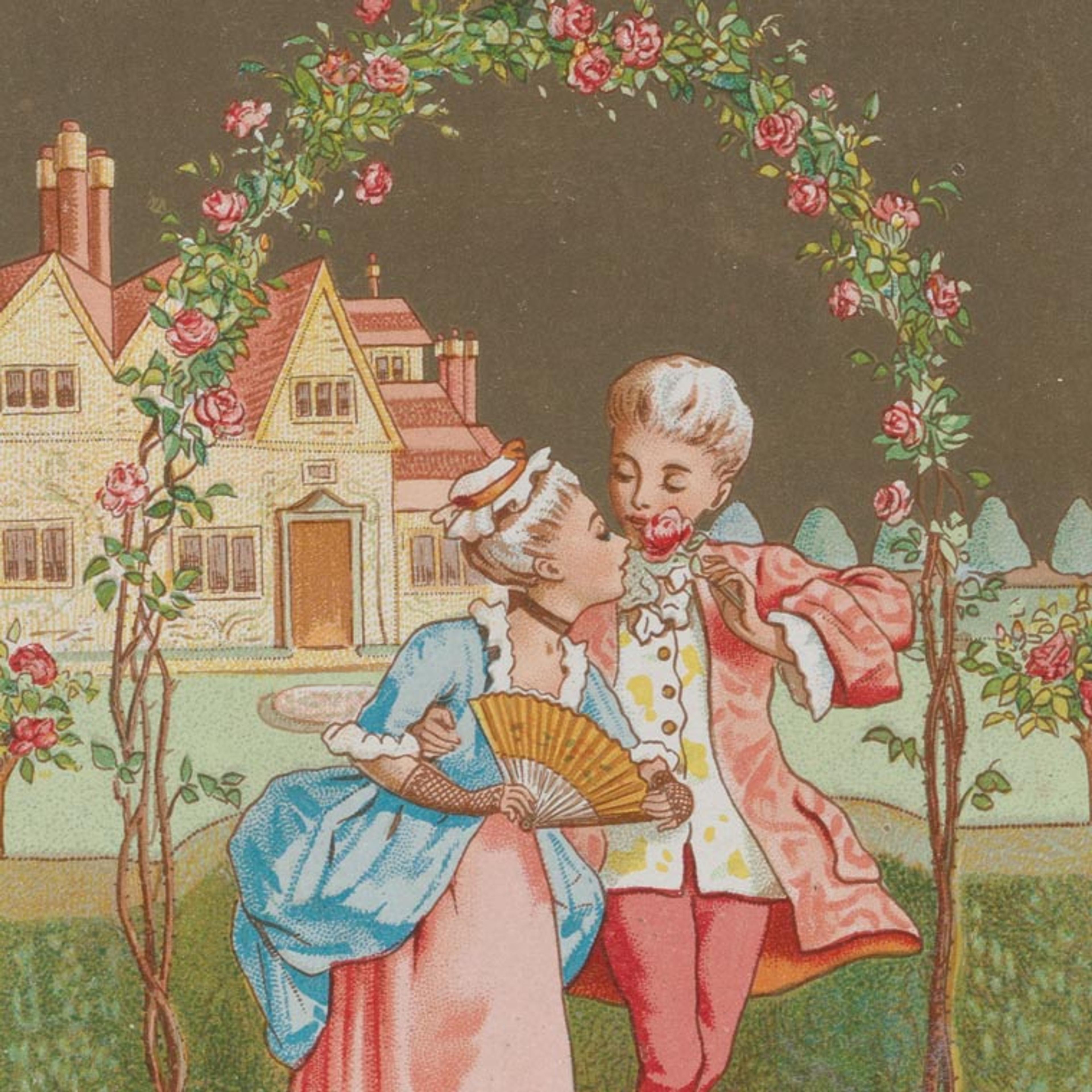
After Kate Greenaway (British, 1846–1901). Printed by Charles Goodall & Sons, London. Top: Valentine, ca. 1880. White card, figures shown in raised cameo embossing; printed with green background, W: 5 3/4 in. (14.6 cm); L: 2 3/8 in. (6 cm). The Metropolitan Museum of Art, New York, Gift of Mrs. Richard Riddell, 1981 (1981.1136.783). Bottom: Valentine, ca. 1880. White card, figures shown in raised cameo embossing; printed with tan background, W: 5 3/4 in. (14.6 cm); L: 2 3/8 in. (6 cm). The Metropolitan Museum of Art, New York, Gift of Mrs. Richard Riddell, 1981 (1981.1136.784)
The Met houses an extensive collection of valentines, illustrated books, and ephemera created by the Victorian artist Catherine (Kate) Greenaway (1846–1901). As a cataloger of valentines, I have had the pleasure of exploring the world of Kate Greenaway and savoring her sensitive expressions of love, which I am thrilled to share with you in celebration of Valentine's Day.
The two Greenaway cameo cards pictured above depict joyful children frolicking and dancing across flower-filled fields, playing games, and pretending to be adults—emblematic elements of the artwork she designed and carefully crafted by hand. Greenaway entranced her audience with charming scenes based on romantic medieval imagery, eighteenth-century costumes, and a touch of fantasy. The significant influence of these depictions fostered a sense of innocence in children's fashion that was recognized as the "Greenaway vogue."
Depicting a world filled with splendor and whimsy, Greenaway became immensely popular through the publication of numerous illustrated books. She worked for various publishers—including Frederick Warne, Marcus Ward, Edmund Evans, George Routledge and Co., and Charles Goodall and Sons—a number of which sought to capitalize on her appealing illustrations by producing popular greeting cards with similar imagery to celebrate birthdays, Christmas, New Year's, and, especially, Saint Valentine's Day.

After Kate Greenaway (British, 1846–1901). Valentine (front and back views), 1879. White card, color lithograph, additional lithography in gold, magenta silk fringe, W: 3 5/8 in. (9.2 cm); L: 5 1/16 in. (12.9 cm). The Metropolitan Museum of Art, New York, Gift of Mrs. Richard Riddell, 1981 (1981.1136.842)
The quaint images Greenaway produced were largely an escape from her grim, urban childhood in London's East End. The daughter of a draftsman and wood engraver who provided images for London Illustrated, Kate was sent to live with relatives in the Nottinghamshire countryside for two years so that her father could concentrate on a commission to create images for Charles Dickens's Pickwick Papers. The project failed, leaving the family without income, but the temporary escape to the lush countryside had inspired Kate's imagination and notions of beauty. To generate income, her mother, a stoic Welshwoman, opened a successful dress shop and instilled in Kate the sense of fashion that she would later incorporate into her artwork.

Greenaway attended the South Kensington School of Art, the Royal Female School of Art, the Heatherley School of Fine Art, and the renowned Slade School of Fine Art. Thanks to her promising work as a watercolorist, she was hired as a greeting card designer for the firm of Marcus Ward in London while still a student, and her earliest book illustrations appeared in 1867. She continued to illustrate children's books and, by 1880, her successful books and colorful wood engravings caused numerous copyists to exploit her work and emulate her manner. Unfortunately, this caused Kate to withdraw from public life and greatly decreased her productivity; she accepted new commissions only to ensure her financial survival.
Left: Elliott and Fry Photographers (British, 1863–1962). Portrait of Kate Greenaway, 1880. Reproduced from the Elliott & Fry Archive in: M. H. Spielmann and G. S. Layard, Kate Greenaway (London: Adam and Charles Black, 1905), 84.
In photographs of her likeness, Greenaway appears almost wistful. Fortunately, by the time of her premature death from breast cancer at age fifty-five, Kate's reputation had been revived by Frederick Warne's reissue of some of her books in both America and Britain. Along with Randolph Caldecott and Walter Crane, she became one of the most popular English illustrators of the time.
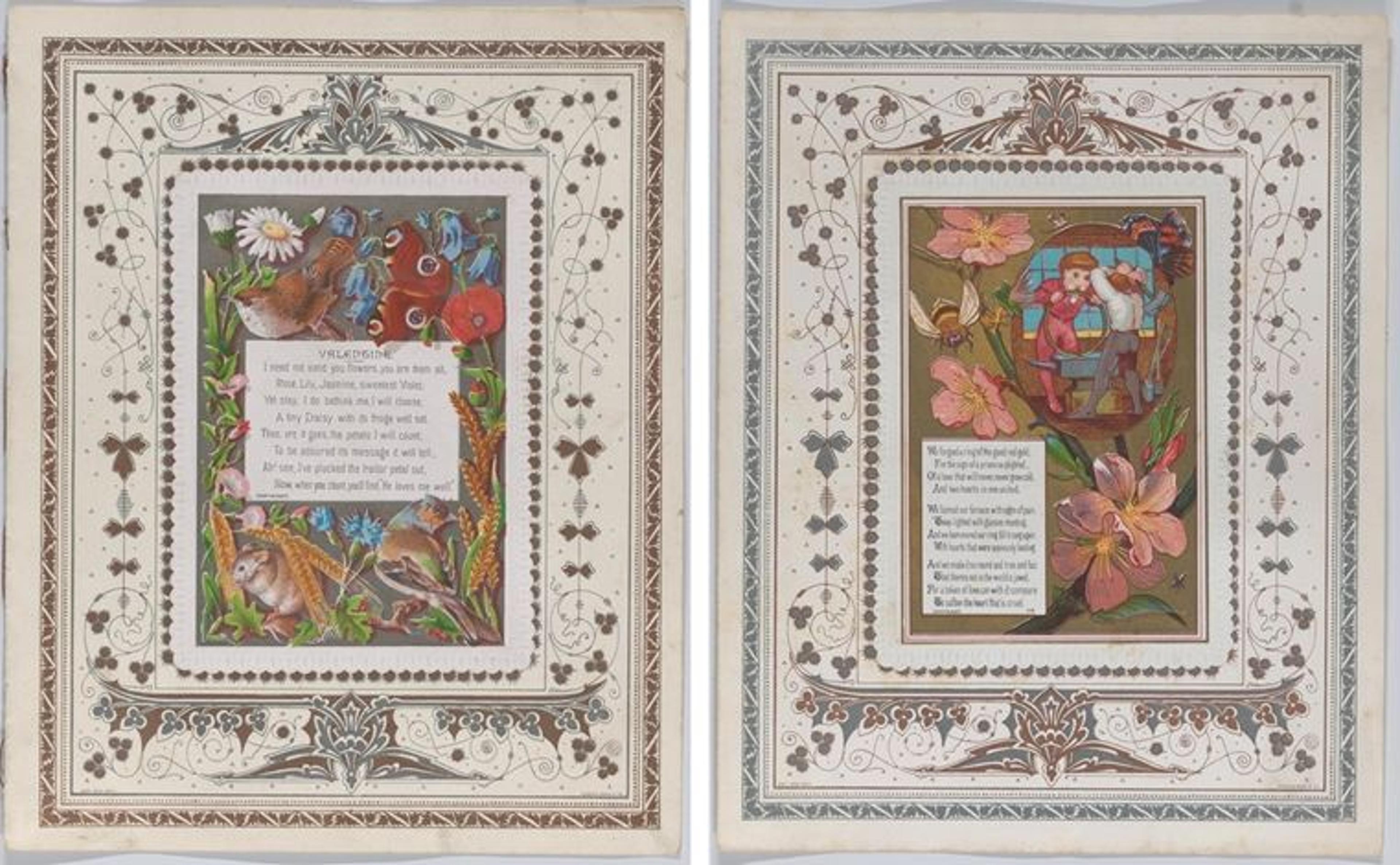
After Kate Greenaway (British, 1846–1901). Left: Valentine, 1874. White card with cameo-embossed, scalloped border, color lithograph, with additional lithography in silver, and cream-colored card stock, W: 7 5/16 in. (18.5 cm); L: 9 1/16 in. (23 cm). The Metropolitan Museum of Art, New York, Gift of Mrs. Richard Riddell, 1981 (1981.1136.819). Right: Valentine, 1874. White card stock with embossed, scalloped borders; color lithograph with additional lithography in gold, on paper insert card with lithography in silver, W: 5 5/16 in.; L: 3 7/8 in. (9.9 cm). The Metropolitan Museum of Art, New York, Gift of Mrs. Richard Riddell, 1981 (1981.1136.794)
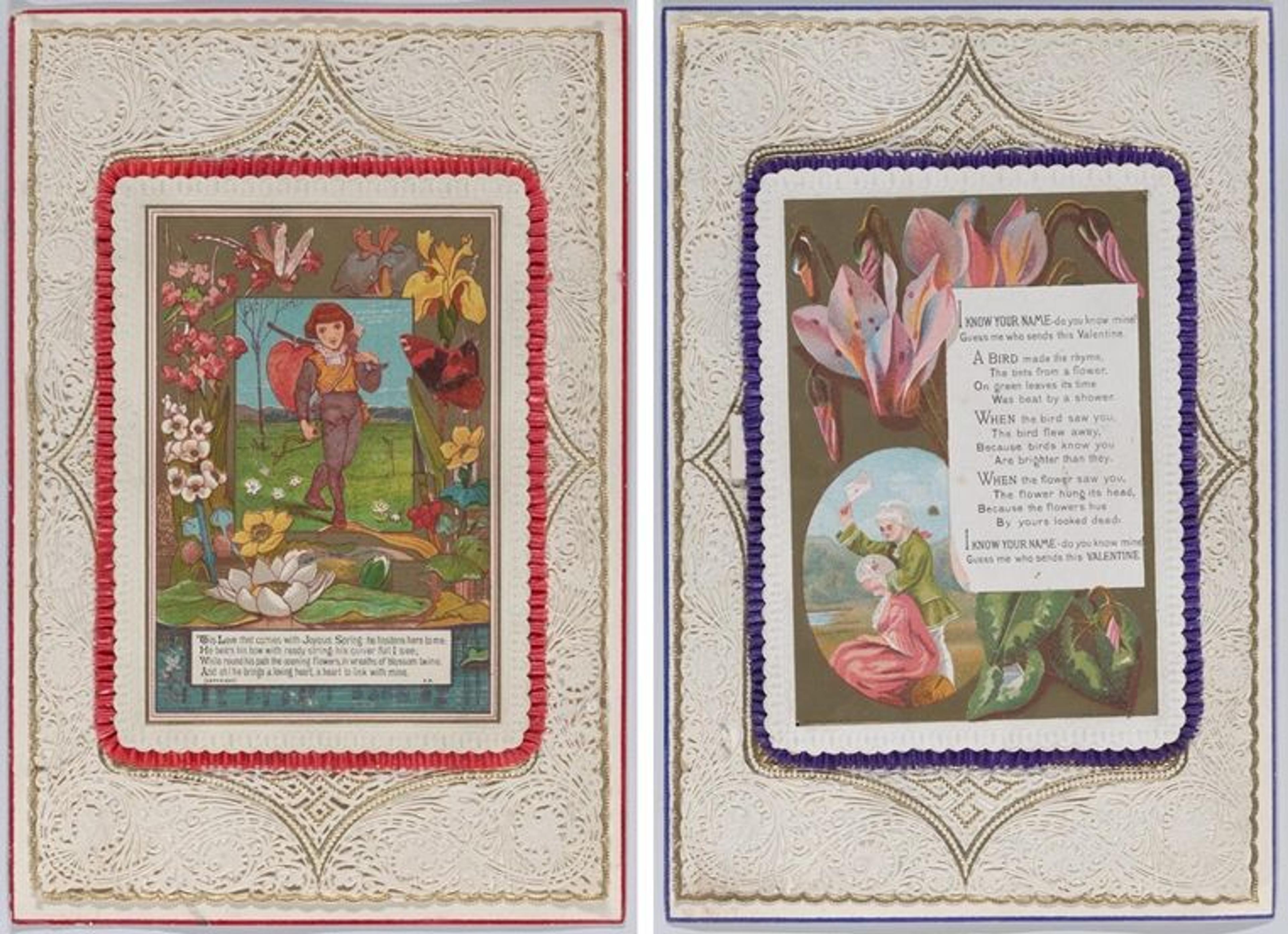
After Kate Greenaway (British, 1846–1901). Left: Valentine, 1874. White card stock with embossed, scalloped borders; color lithograph with additional lithography in gold, gilded open work lace paper, purple pleated silk, purple watercolor, white paper, insert card W: 5 5/16 in. (13.5 cm); L: 3 7/8 in. (9.9 cm). The Metropolitan Museum of Art, New York, Gift of Mrs. Richard Riddell, 1981 (1981.1136.792). Valentine, 1874. White card stock with embossed, scalloped borders; color lithograph with additional lithography in gold, gilded open work lace paper, red pleated silk, red watercolor, white paper, insert card W: 5 5/16 in. (13.5 cm); L: 3 7/8 in. (9.9 cm). The Metropolitan Museum of Art, New York, Gift of Mrs. Richard Riddell, 1981 (1981.1136.793)
Above is a sampling of four of Greenaway's cards in The Met collection published by Marcus Ward and Co., London. The cards combine her characteristic scenes of children with poetry, and beautiful framing motifs of flora and fauna printed in vibrant colors that reflect Greenaway's love of animals and nature. An outer frame of exquisite gold-edged lace paper and silk ruffles made these cards stand out further. Through folded-paper hinges, some of the cards could be lifted from the lace panel for a dramatic shadow-box effect.
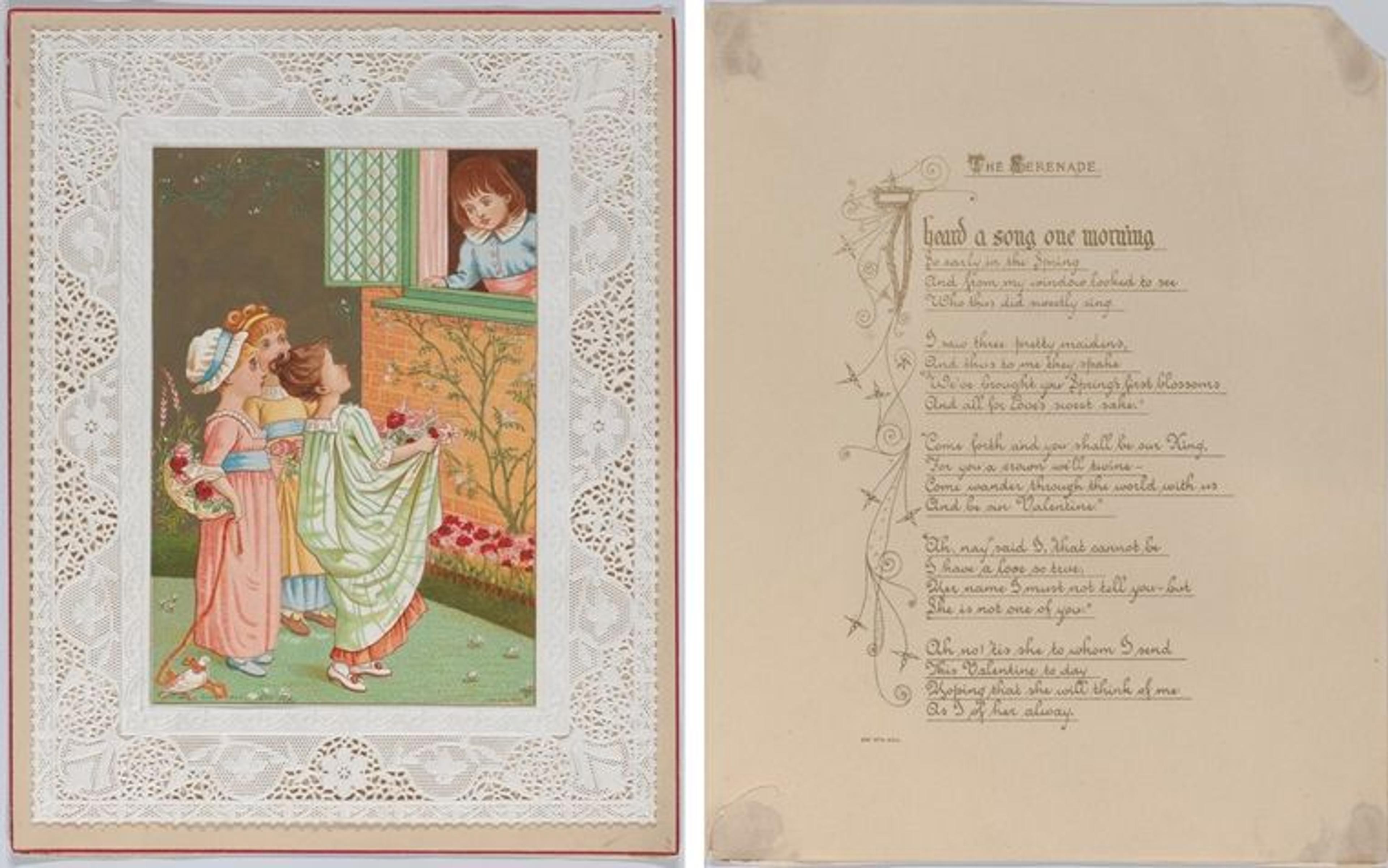
After Kate Greenaway (British, 1846–1901). Valentine (The Serenade) (front and back views), ca. 1880. White card stock with gilding; color lithograph, with additional gold lithography, beige paper, red watercolor, cameo-embossed lace paper, W: 5 7/8 in. (15 cm); L: 7 3/8 in. (18.7 cm). The Metropolitan Museum of Art, New York, Gift of Mrs. Richard Riddell, 1981 (1981.1136.805)
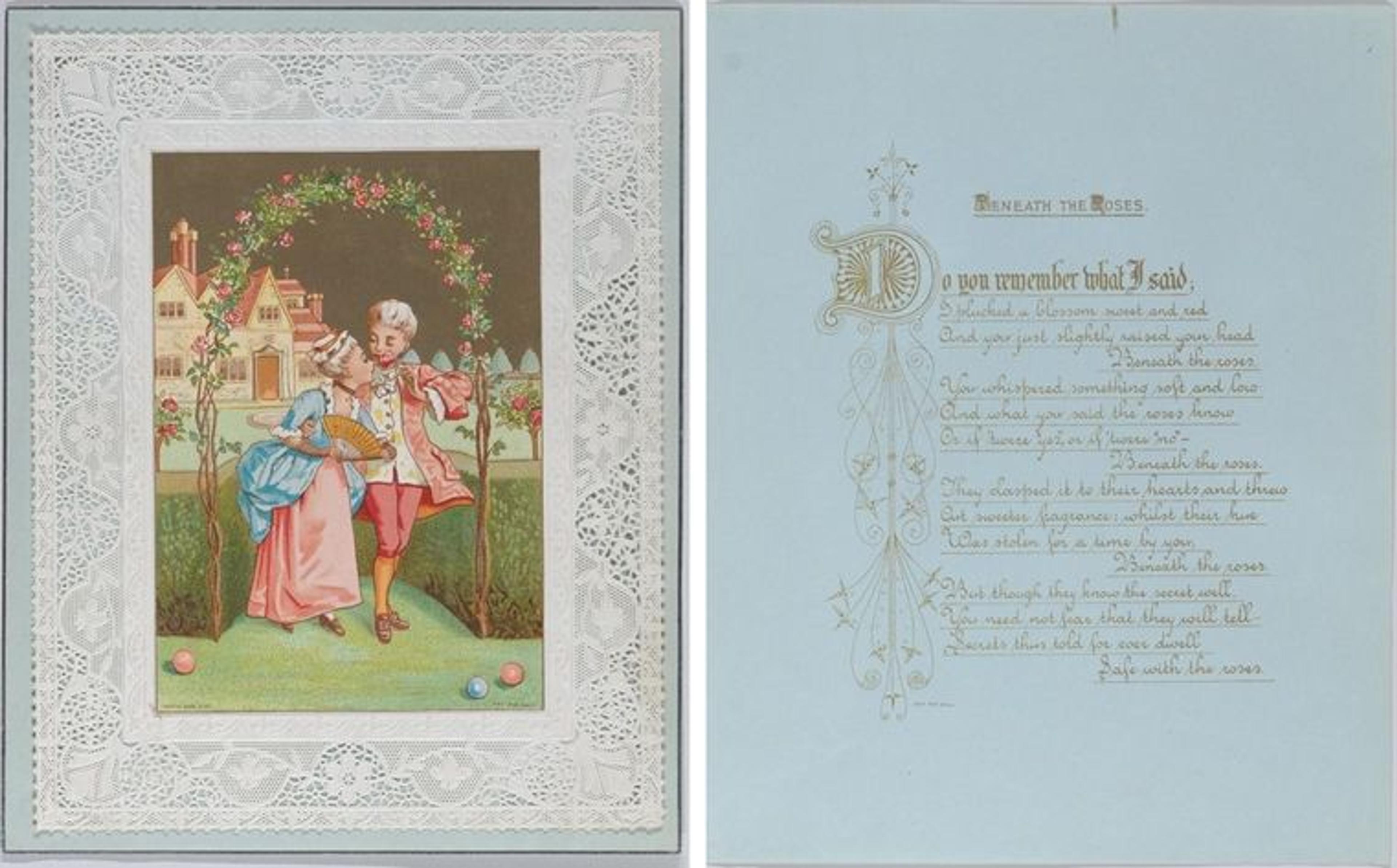
After Kate Greenaway (British, 1846–1901). Valentine (Floral Arch) (front and back views), ca. 1880. White card stock with gilding; color lithograph, with additional gold lithography, blue paper, blue watercolor, cameo-embossed lace paper, W: 5 7/8 in. (15 cm); L: 7 3/8 in. (18.7 cm). The Metropolitan Museum of Art, New York, Gift of Mrs. Richard Riddell, 1981 (1981.1136.804)
Among the most joyful and well-known Greenaway cards are The Serenade and Floral Arch. Both contain scenes with Greenaway's eighteenth-century-inspired fashions and are mounted on lace cards accompanied by gold-printed poetry. The Serenade shows three maidens dressed in Greenaway's beloved gowns accented with colorful fabrics and sashes; one is even wearing a mob hat. They are offering a Valentine's Day song to a young boy leaning out of an open window, and asking him to be their "king" and valentine. Floral Arch, sometimes also referred to as Beneath the Roses, shows an elegant couple tenderly walking beneath an arch of roses. The gentleman's right hand tenderly embraces his lover's waist as he offers a rose and she leans towards him to inhale its scent.
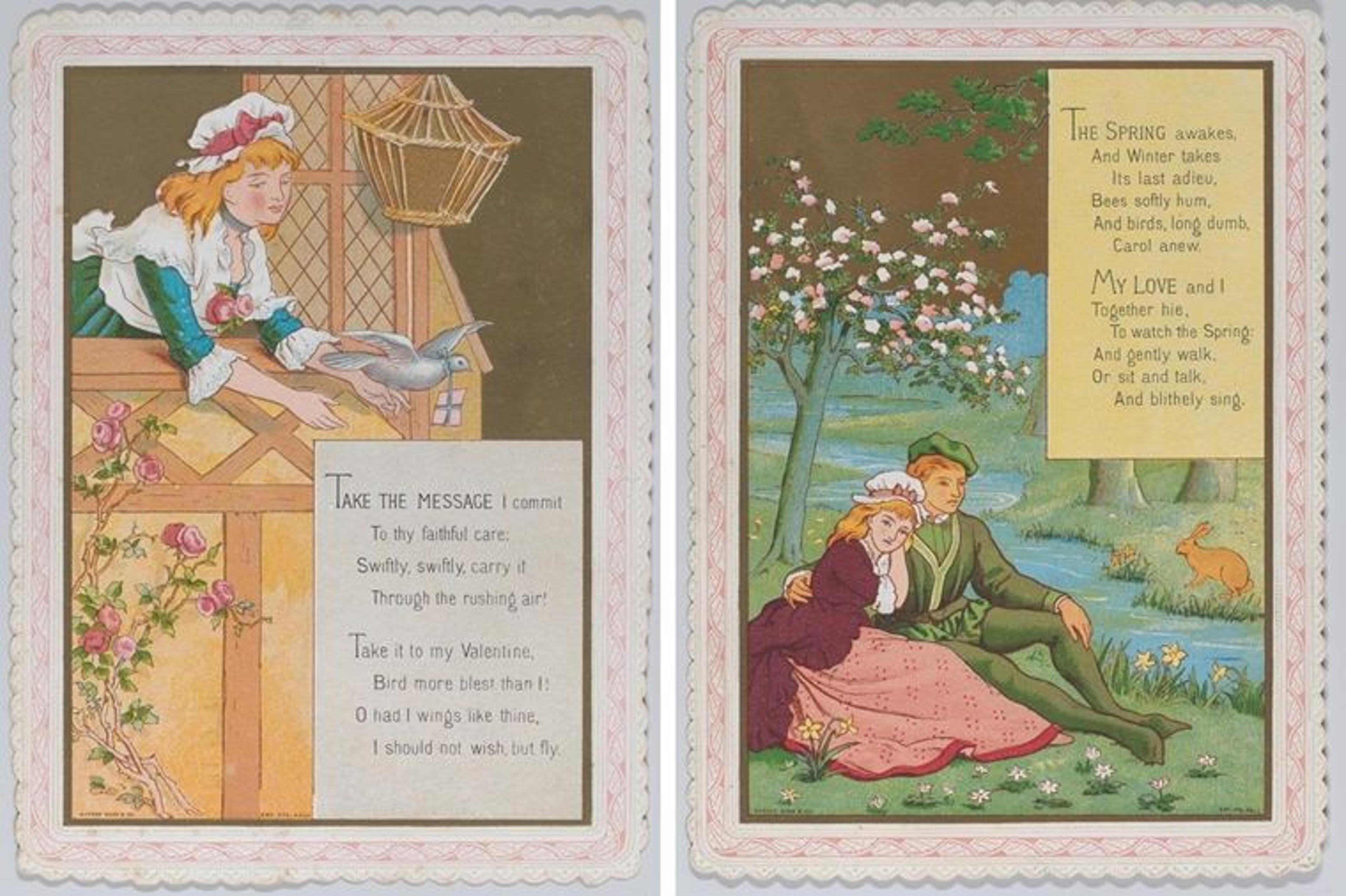
After Kate Greenaway (British, 1846–1901). Left: Valentine, 1874. White card stock with gilt and scalloped borders; color lithograph, graphite, W: 6 11/16 in. (17 cm); L: 4 13/16 in. (12.2 cm). The Metropolitan Museum of Art, New York, Gift of Mrs. Richard Riddell, 1981 (1981.1136.789). Right: Valentine, 1874. White card stock with gilt and scalloped borders; color lithograph, W: 6 11/16 in. (17 cm); L: 4 13/16 in. (12.2 cm). The Metropolitan Museum of Art, New York, Gift of Mrs. Richard Riddell, 1981 (1981.1136.788)
The following year, Marcus Ward and Co. published Quiver of Love: A Collection of Valentines Ancient and Modern, which contained four illustrations by Walter Crane and four by Greenaway. The images were closely akin, but their authorship could be easily discerned because the Crane images have gold backgrounds while the Greenaways do not. The images were accompanied by poems in the style of a traditional valentine writer, which were meant to provide inspiration for the tongue-tied suitor and were later often reproduced as cards as well.
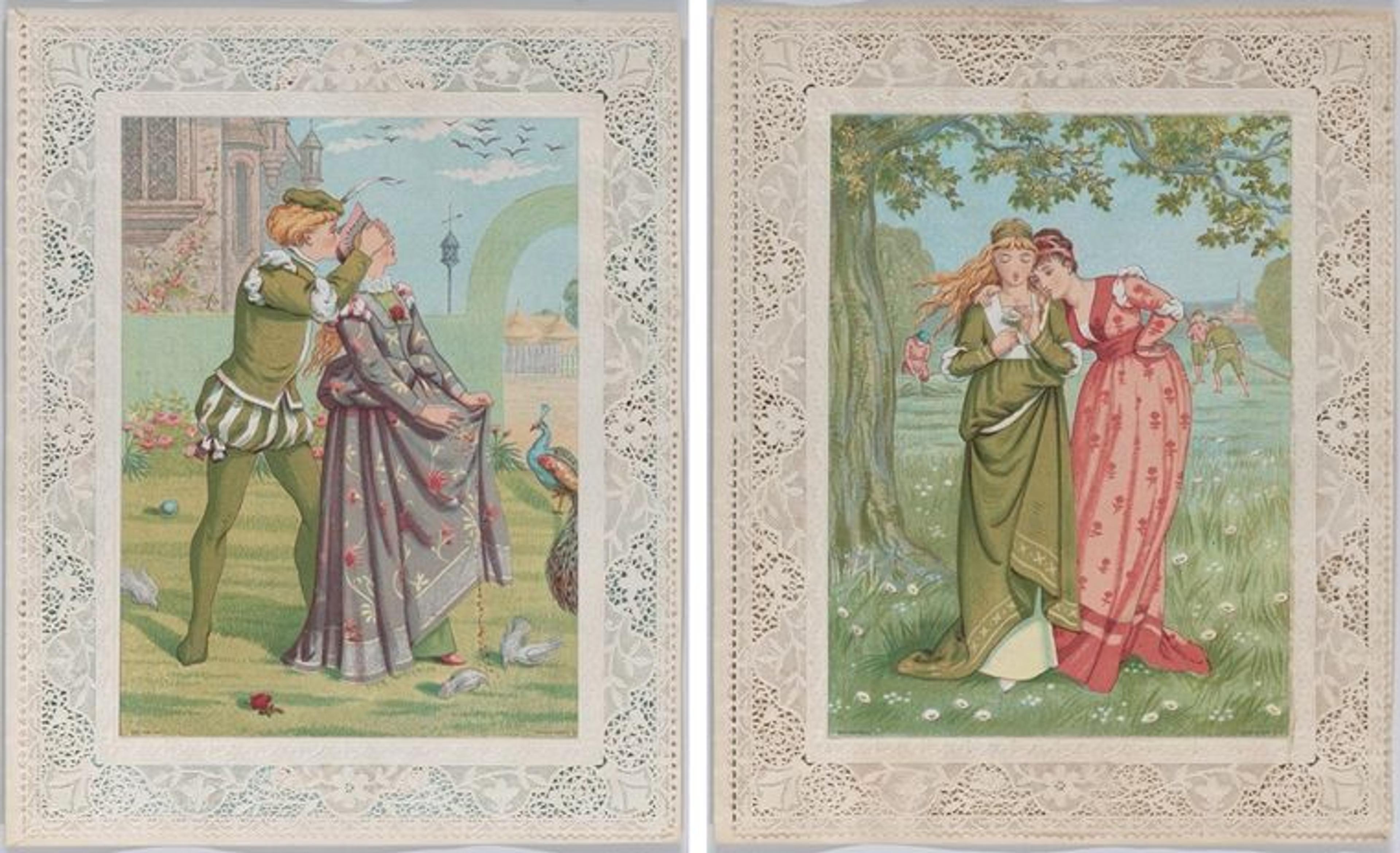
After Kate Greenaway (British, 1846–1901). Left: Valentine (Surprise), 1876. White card stock with gilding; color lithograph, with additional lithography in gold, openwork lace paper, W: 4 15/16 in. (12.5 cm); L: 6 11/16 in. (17 cm). The Metropolitan Museum of Art, New York, Gift of Mrs. Richard Riddell, 1981 (1981.1136.796). Right: Valentine (Do I Love You?), 1876. White card stock with gilding; color lithograph, with additional lithography in gold, openwork lace paper, W: 4 15/16 in. (12.5 cm); L: 6 11/16 in. (17 cm). The Metropolitan Museum of Art, New York, Gift of Mrs. Richard Riddell, 1981 (1981.1136.797)
In Surprise, we observe that covering the eyes of one's beloved to create a surprise is a time-honored custom! This card depicts a young medieval couple, the suitor playfully covering his lady's eyes with his hands—a surprise that causes her to spill the grain she had been feeding the doves. Greenaway has included a peacock in her drawing as a symbol of nobility and integrity. Throughout her illustrations, she would often include such symbols to encourage the viewer to study the details and discover the hidden meaning of her imagery.
Such is the case in the provocative image seen on Do I Love You?, which features two women in a Romantic version of medieval garments as they pluck petals from a daisy in the familiar yes-and-no game of "Does he love me?" The symbolic background image shows a church and people harvesting hay, which signify holy marriage, abundance, and fertility, inspiring hopes of a positive outcome of the game and a happily-ever-after ending for the lucky couple.

After Kate Greenaway (British, 1846–1901). Left: Valentine (Summer) (two views), 1876. White card stock with gilding; white card with embossed border; color lithograph, with additional lithography in gold, W: 2 5/8 in. (6.6 cm); L: 3 11/16 in. (9.4 cm). The Metropolitan Museum of Art, New York, Gift of Mrs. Richard Riddell, 1981 (1981.1136.796). Right: Valentine with pull tabs opened
Greenaway's images were highly versatile and used for more occasions than Valentine's Day alone. Sometimes the same image could serve multiple functions. For example, the illustration of Summer shown above as a New Year's wish, was also used as a valentine. Not only the imagery, but also the cards themselves could be used in various ways. It could be sold as a simple card, but the same card was also offered with a magical "open-out" mechanism, such as our version of Summer, which has pull tabs on each side that reveal additional messages in the flowers!
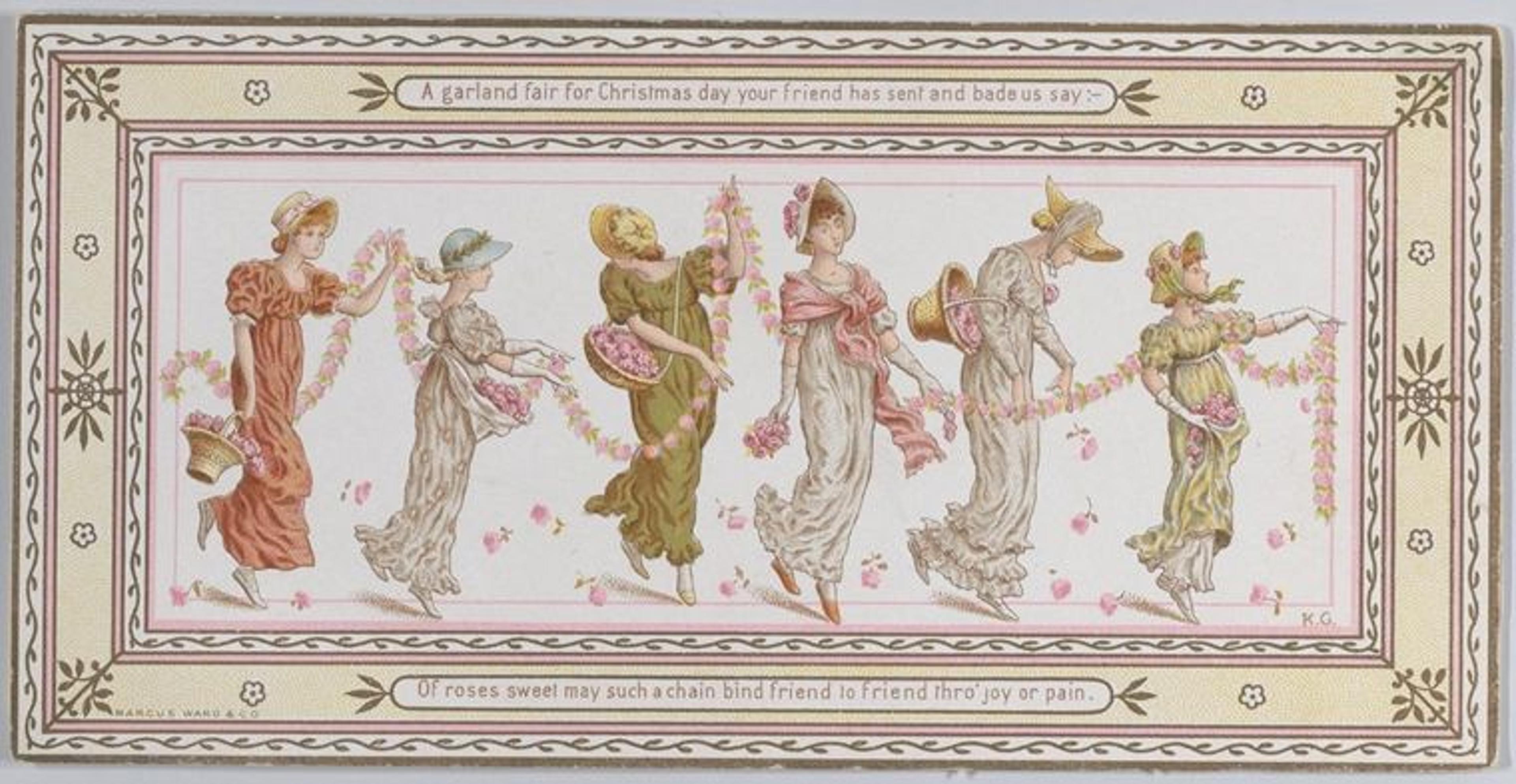
After Kate Greenaway (British, 1846–1901). Valentine (Procession), 1881. White glossy card stock, color lithograph, with additional lithography in gold, W: 6 1/4 in. (15.9 cm); L: 3 1/8 in. (7.9 cm). The Metropolitan Museum of Art, New York, Gift of Mrs. Richard Riddell, 1981 (1981.1136.782)
That Greenaway's universally endearing language could be used for many occasions is also shown by the graceful dancing maidens in the wondrous Procession, published by Marcus Ward and Co. in 1881. While the message here is meant for Christmas, as identified through the text in the layered border of pastel pink and yellow, the imagery of the card would have also worked well with a Valentine's Day message.
Children and young love, birds and flowers, fairy tales and fantasy are the essence of Greenaway's unmistakable art. Her imagination and artistry have given us some of the most memorable treasures of Victoriana, and have filled many a nineteenth-century heart with joy and love.
